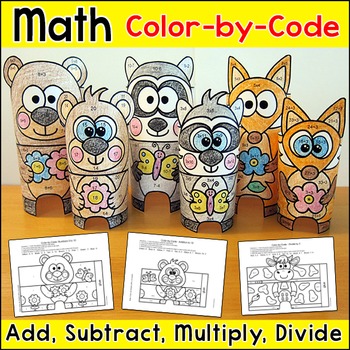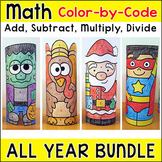Mother Animals & Babies Color by Number Spring Math Craft Activity - Craftivity
- Zip
What educators are saying
Also included in
- Practice number matching, adding, subtracting, multiplying or dividing with these differentiated and engaging color-by-code pictures that turn into 3D paper toys! This activity is perfect for math centers, morning work, early finishers, substitutes or homework. This bundle contains the following thePrice $29.99Original Price $59.36Save $29.37
Description
Practice number matching, adding, subtracting, multiplying or dividing with these fun Spring Animal Babies and Mothers color by number pictures that turn into a 3D paper toys! This activity is perfect for math centers, morning work, early finishers, substitutes or homework.
This product includes 8 pictures: Cow & Baby, Raccoon & Baby, Bear & Baby, Fox & Baby.
Each picture has 33 worksheets for the following skills: matching numbers to 20, number words, addition to 20, subtraction within 20, doubles addition, doubles + 1 addition, multiplication from 1 to 12 and division from 1 to 12. You can choose the most appropriate question set for your students which makes the activity perfect for differentiation and many grade levels.
When students have completed their characters, display them on a table or hang them from the ceiling for a fun and eye catching Spring display. Students will be excited to take them home and show their parents.
Easy to Assemble!
When coloring is completed, cut out the picture and then apply stick glue to the “glue” area. Bend the picture into a cylinder and then overlap the edges so that the glue makes contact with the paper. Tape or a stapler also work well if you prefer not to use glue.
Table of Contents per Picture
Page 2: Color Answer Key
Page 3 – Number Match 0 to 10
Page 4 – Number Match 11 to 20
Page 5 – Number Words 1 to 10
Page 6 – Addition to 10
Page 7 – Addition to 20
Page 8 – Subtraction within 10
Page 9 – Subtraction within 20
Page 10 – Doubles addition
Page 11 – Doubles + 1 addition
Pages 12 to 23: Multiplication facts from 1 to 12
Pages 24 to 35: Division facts from 1 to 12
You may like my other Color by Code 3D Characters Activities.
You may like my other Spring activities:
Spring Math Mystery Pictures Mural
Spring Bees Interactive Attendance
Spring Math Coordinate Graphing Mystery Pictures
Click a link below to see all activities in that category:
- Math Color-by-Code Worksheets
- Sight Words Mystery Pictures
- Sight Words Color-by-Code Worksheets
CBC CBCMath CBC3D SprAct






